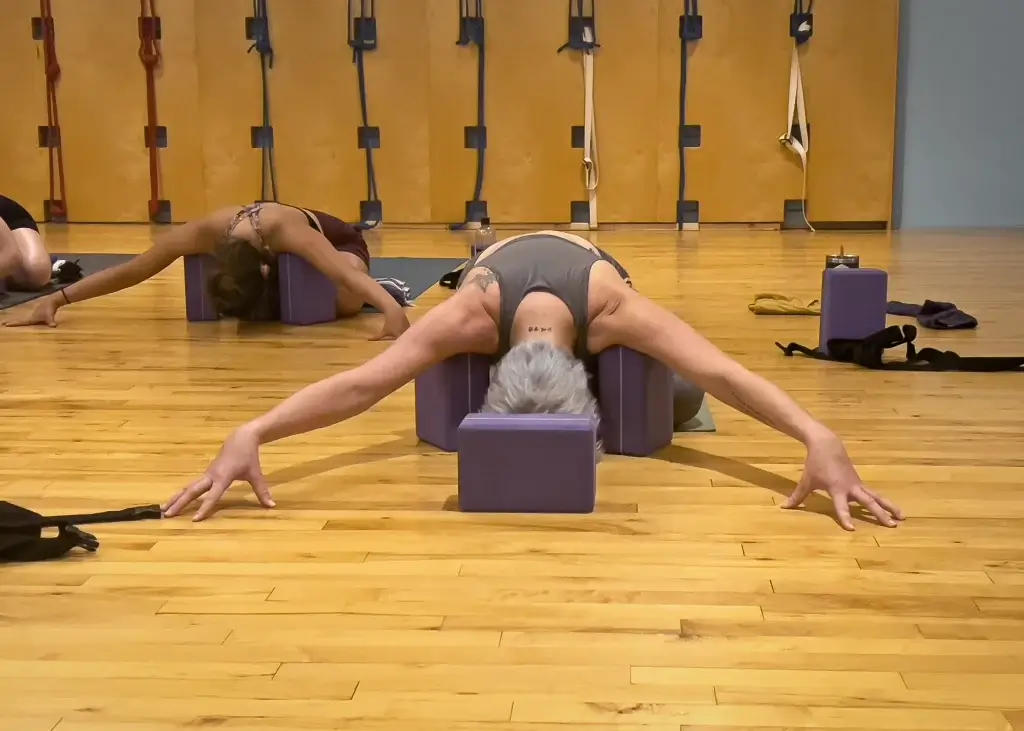
You probably already know the value of building rest and recovery days into your fitness routine, but are you being intentional in how you approach rest? While your body may be getting a break, do you find yourself turning towards mental distraction and feeding your mind with input that could be dis-regulating for your nervous system? This can leave you feeling more groggy, irritable, and exhausted than before! On days like these, maybe your first instinct is to skip the gym and “check out”. But what if, instead, you took the opportunity to “check in”? Practices like Restorative and Yin Yoga offer the opportunity to rest your body AND to clear your mind.
WHAT IS YIN AND RESTORATIVE YOGA, AND WHAT ARE THE DIFFERENCES BETWEEN THEM?
Unlike more active asana (physical) practices like Vinyasa or Hatha Yoga, Restorative and Yin primarily aim to soothe the nervous system. Many practitioners find these practices more accessible because they are gentler, and mostly, if not always, done lying or sitting on the floor. It is great for beginners or those working through an injury. With both formats, you can expect to use props like blocks, straps, bolsters (pillows), and blankets to support your body in long-held postures that require no effort or muscular activation. Depending on the practice, you’ll stretch, twist, and compress the soft tissue in the body (IE fascia, tendons, and ligaments) while holding poses from three to twenty minutes. This gives your body ample time to release deeply held layers of tension and physical stress. Targeting the major joints in the body (hips, shoulders, and spine) will help increase flexibility and range of motion over time.
While the two formats are very similar, there are some differences in the goal of practice. Yin Yoga focuses on deeply stretching the connective tissues, such as ligaments, joints, bones, tendons, and deep fascia networks. A Restorative Yoga practice aims to establish full-body relaxation with postures that aid the body in releasing tension and soothing the nervous system.
BENEFITS THAT GO DEEP
Beyond the physical benefits, Restorative and Yin Yoga provide much-needed space and time away from our daily to-dos, space where our mind can settle. You may be guided through body, breath, or imaginative cues to help you stay present and engaged in your rest experience. By being grounded in the moment physically and mentally, your nervous system will begin to regulate and return to homeostasis by flipping the Sympathetic Nervous System (fight or flight) into the Parasympathetic Nervous System response (rest and digest). This manifests as deeper, more balanced respiration and a slowed heart rate. A settled nervous system leads to better sleep, improved digestion, and boosted immunity. Over time, this can reduce cortisol and other stress hormone levels in the body. Another benefit of a healthy nervous system is optimized cognitive function, such as better memory, improved critical thinking, and the ability to make decisions with more clarity.
EXPERIENCE THE BENEFITS OF YIN AND RESTORATIVE YOGA AT CASTLE HILL FITNESS
With all of these benefits, it’s easy to see why we offer multiple Restorative and Yin classes each week. Some of these you can even take from home! So the next time you find yourself thinking about skipping out on the gym completely, try signing up for one of these replenishing classes instead.